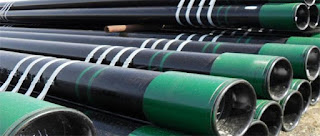 |
| Casing Pipe for Oil Gas Well |
In practice, it would be much cheaper to drill a hole to total depth (TD), probably with a small
diameter drill bit, and then case the hole from surface to TD. However, the presence of high pressured zones at different depths along the wellbore, and the presence of weak, unconsolidated formations or sloughing, shaly zones, necessitates running casing to seal off these troublesome zones and to allow the drilling to TD. Thus, different sizes of casing are employed and this arrangement gives a tapered shape to the finished well.
The types of casing currently in use are as follows:
- Stove Pipe
Stove pipe (or marine-conductor, or foundation-pile for offshore drilling) is run to prevent washouts of near-surface unconsolidated formations, to provide a circulation system for the drilling mud and to ensure the stability of the ground surface upon which the rig is sited. This pipe does not usually carry any weight from the wellhead equipment and can be driven into the ground or seabed with a pile driver. A typical size for a stove pipe ranges from 26 in. to 42 in.
2. Conductor Pipe
Conductor pipe is run from the surface to a shallow depth to protect near surface unconsolidated formations, seal off shallow-water zones, provide protection against shallow gas flows, and provide a conduit for the drilling mud. One or more BOPs may be mounted on this casing or a diverter system if the setting depth of the conductor pipe is shallow. In the Middle East, a typical size for a conductor pipe is either 18 5/8 in. (473 mm) or 20 in. (508 mm). In North Sea exploration wells, the size of the conductor pipe is usually 26 or 30 in also in most of Iraqi wells. Conductor pipe is always cemented to surface. It is used to support subsequent casing strings and wellhead equipment or alternatively the pipe is cut off at the surface after setting the surface casing.
3. Surface Casing
Surface casing is run to prevent caving of weak formations that are encountered at shallow
depths. This casing should be set in competent rocks such as hard limestone. This will ensure that formations at the casing shoe will not fracture at the high hydrostatic pressures which may be encountered later. The surface casing also serves to provide protection against shallow blowouts, hence BOPs are connected to the top of this string. The setting depth of this casing string is chosen so that troublesome formations, thief zones, water sands, shallow hydrocarbon zones and build-up sections of deviated wells may be protected. A typical size of this casing is l3 3/8 in. (240 mm) in the Middle East and 18 5/8 in. or 20 in. in North Sea operations.
4. Production Casing
Production casing is the last casing string. It is run to isolate producing zones, to provide reservoir fluid control and to permit selective production in multizone production. This is the string through which the well will be completed. The usual sizes of this string are 4 1/2, 5 and 7 in.
6. Liners
A liner is a string of casing that does not reach the surface. Liners are hung on the intermediate casing by use of a liner-hanger. In liner completions both the liner and the intermediate casing act as the production string. Because a liner is set at the bottom and hung from the intermediate casing, the major design criterion for a liner is usually the ability to withstand the maximum expected collapse pressure.
Casing Pipe
ReplyDelete